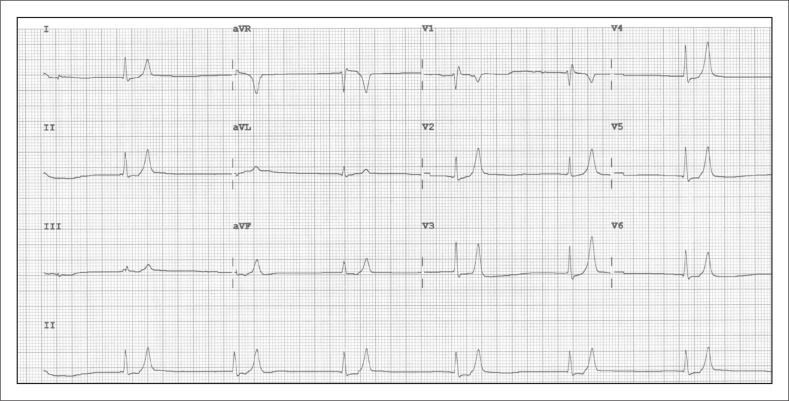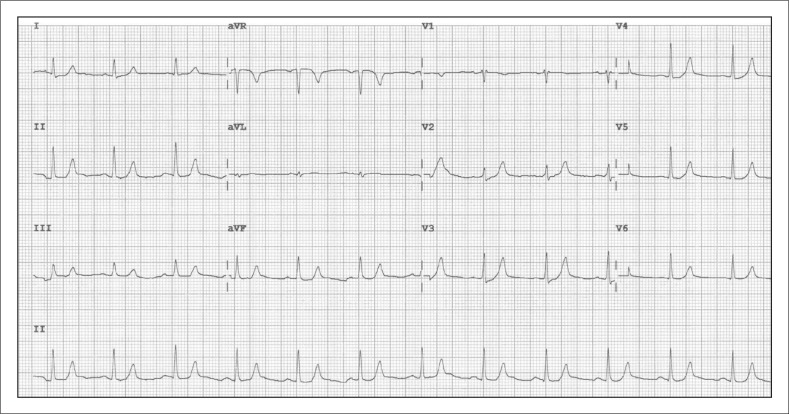Diagnosis of hyperkalemia is usually based on laboratory studies, although the electrocardiogram (ECG) may contain changes suggestive of hyperkalemia. Typical ECG findings in hyperkalemia progress from tall, “peaked” T waves and a shortened QT interval to lengthening PR interval and loss of P waves, and then to widening of the QRS complex culminating in a “sine wave” morphology and death if not treated.1–3 Treatment of life-threatening hyperkalemia focuses on blocking the effects on myocyte transmembrane potential and cardiac conduction, as well as decreasing extracellular potassium levels.3 Calcium (intravenous calcium chloride or gluconate) can effectively block the effect of extracellular potassium elevation on cardiac myocytes within minutes by restoring a more appropriate electrical gradient across the cellular membrane.2 Sodium bicarbonate, beta-2 adrenergic agonists, and the combination of glucose and insulin all drive potassium intracellularly and lower the extracellular serum potassium level.3 Finally, excessive body potassium can be removed with sodium polystyrene sulfonate (Kayexalate), whereas hemodialysis represents the definitive method to reduce serum potassium levels.2,3
Figure 1.
12-lead ECG from an 82-year-old man with acute renal failure and hyperkalemia (serum potassium 8.6 mEq/dL).
Demonstrates a ventricular junctional escape rhythm (41 beats/min), with absence of P waves and peaked T waves.
Figure 2.
12-lead ECG from same patient following treatment of hyperkalemia with intravenous calcium gluconate, insulin, glucose, normal saline, and oral kayexalate (serum potassium 6.2 mEq/dL).
Demonstrates a normal sinus rhythm (75 beats/min) with resolving peaked T waves.
References
- 1.Slovis C, Jenkins R. ABC of clinical electrocardiography: Conditions not primarily affecting the heart. BMJ. 2002 Jun 1;324(7349):1320–3. doi: 10.1136/bmj.324.7349.1320. DOI: http://dx.doi.org/10.1136/bmj.324.7349.1320 Erratum in: BMJ 2002 Aug 3; 325(7358):259. BMJ 2007 May 26;334(7603). DOI: http://dx.doi.org/10.1136/bmj.39219.615243.AD. [DOI] [PMC free article] [PubMed] [Google Scholar]
- 2.Webster A, Brady W, Morris F. Recognising signs of danger: EKG changes resulting from an abnormal serum potassium concentration. Emerg Med J. 2002 Jan 19;19(1):74–7. doi: 10.1136/emj.19.1.74. DOI: http://dx.doi.org/10.1136/emj.19.1.74. [DOI] [PMC free article] [PubMed] [Google Scholar]
- 3.Diercks DB, Shumaik GM, Harrigan RA, Brady WJ, Chan TC. Electrocardiographic manifestations: electrolyte abnormalities. J Emerg Med. 2004 Aug;27(2):153–60. doi: 10.1016/j.jemermed.2004.04.006. DOI: http://dx.doi.org/10.1016/j.jemermed.2004.04.006. [DOI] [PubMed] [Google Scholar]




